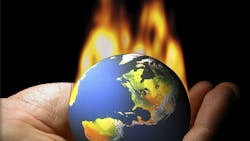Severe droughts, floods and heat waves rocked the world last year as greenhouse gas levels climbed, likely boosting the odds of extreme weather events, international scientists said Tuesday.
The details are contained in the annual "State of the Climate in 2011" report, compiled by nearly 400 scientists from 48 countries and published in the peer-reviewed Bulletin of the American Meteorological Society.
The report itself remains "consciously conservative" when it comes to attributing the causes of certain weather events to climate change, and instead refers only to widely understood phenomena such as La Nina, it said.
However, it is accompanied for the first time by a separate analysis that explains how climate change may have influenced a selection of key events, from droughts in the United States and Africa to extreme cold and warm spells in Britain.
"2011 will be remembered as a year of extreme events, both in the United States and around the world," said Kathryn Sullivan, deputy administrator of the National Oceanic and Atmospheric Administration (NOAA).
"Every weather event that happens now takes place in the context of a changing global environment," she said, adding the reports shed light on "what has happened so we can all prepare for what is to come."
2011 Among the 15 Warmest Years
Last year was among the 15 warmest since documentation began in the late 1800s, and the Arctic warmed at about twice the rate of lower latitudes with sea ice at below average levels, said the report.
Greenhouse gases from human pollution sources like coal and gas reached a new high, with carbon dioxide emissions exceeding 390 parts per million -- up 2.10 ppm from 2010 -- for the first time since modern records began.
Despite the natural cooling trend brought by back-to-back La Ninas, which chill waters in the eastern equatorial Pacific Ocean, 2011 global sea surface temperature was among the 12 highest years on record.
The double La Nina punch influenced many of the world's significant weather events, like historic droughts in East Africa, the southern United States and northern Mexico, said the report.
La Nina trends also were associated with the wettest two years on record in Australia, it said.
An accompanying analysis in the same journal, titled "Explaining Extreme Events," examined the links between climate change and six selected weather crises in 2011, including the Texas drought that lasted half the year.
By comparing it to extreme heat events during La Nina years in the 1960s, the authors found "conditions leading to droughts such as the one in Texas in 2011 are, at least in the case of temperature, distinctly more probable than they were 40 to 50 years ago."
Looking at Britain's unusually warm November 2011 and the cold snap of December 2010, scientists found that cold Decembers are half as likely to occur now compared to 50 years ago, and warm Novembers are 62 times more likely.
However, a close look at the floods along the Chao Phraya River that swamped Thailand last year showed that climate change was not to blame, rather human activities that increased construction along the flood plain.
The damage caused by the floods was unprecedented, but the amount of rain that actually fell "was not very unusual," said the analysis by experts from the NOAA and Britain's Met Office along with international colleagues.
While it remains hard to link single events to human-caused climate change, "scientific thinking has moved on and now it is widely accepted that attribution statements about individual weather or climate events are possible."
The key is analyzing what extent climate change may be boosting the odds of extreme weather, said the report, likening the phenomenon to a baseball player who takes steroids and sees his hit production rise by 20%.
Scientists can consider steroids as the likely cause for the increase in hits, but must still take care to account for natural variability in the player's swing.
Copyright 2012 Agence France-Presse
